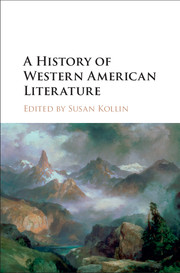Book contents
- Frontmatter
- Contents
- Notes on Contributors
- Acknowledgments
- Introduction: Historicizing the American Literary West
- PART I HOMELANDS
- PART II MAKING A REGION
- PART III GEOGRAPHIES OF THE LITERARY WEST
- PART IV THE TWENTIETH CENTURY AND BEYOND: LITERARY MOVEMENTS AND CRITICAL PERSPECTIVES
- 14 Early Cinematic Westerns
- 15 The Environmental Novel of the American West
- 16 Hard-Boiled Fiction and Noir Narratives
- 17 The Beats and the American West
- 18 Contested Wests: Indigenous Americans and the Literature of Sovereignty
- 19 Asian American Writers and the Making of the Western U.S. Landscape
- 20 African American Literature: Recasting Region through Race
- 21 Hollywood Westerns: 1930s to the Present
- 22 Urban New Wests
- 23 Queer Frontiers: Gender and Sexuality in the American West
- 24 Postwestern Literature and Criticism
- Selected Bibliography
- Index
21 - Hollywood Westerns: 1930s to the Present
from PART IV - THE TWENTIETH CENTURY AND BEYOND: LITERARY MOVEMENTS AND CRITICAL PERSPECTIVES
Published online by Cambridge University Press: 05 November 2015
- Frontmatter
- Contents
- Notes on Contributors
- Acknowledgments
- Introduction: Historicizing the American Literary West
- PART I HOMELANDS
- PART II MAKING A REGION
- PART III GEOGRAPHIES OF THE LITERARY WEST
- PART IV THE TWENTIETH CENTURY AND BEYOND: LITERARY MOVEMENTS AND CRITICAL PERSPECTIVES
- 14 Early Cinematic Westerns
- 15 The Environmental Novel of the American West
- 16 Hard-Boiled Fiction and Noir Narratives
- 17 The Beats and the American West
- 18 Contested Wests: Indigenous Americans and the Literature of Sovereignty
- 19 Asian American Writers and the Making of the Western U.S. Landscape
- 20 African American Literature: Recasting Region through Race
- 21 Hollywood Westerns: 1930s to the Present
- 22 Urban New Wests
- 23 Queer Frontiers: Gender and Sexuality in the American West
- 24 Postwestern Literature and Criticism
- Selected Bibliography
- Index
Summary
From the late 1930s up until the 1960s, the western was one of the most popular movie genres in the United States, and westerns routinely ranked among the highest earning films in any given year. This period, often referred to as the genre's golden age, saw the release of celebrated westerns such as Stagecoach (John Ford, 1939), Red River (Howard Hawks, 1948), High Noon (Fred Zinnemann, 1952), Shane (George Stevens, 1953), The Searchers (John Ford, 1956), Rio Bravo (Howard Hawks, 1959), The Magnificent Seven (John Sturges, 1960), along with countless others. In the 1940s and 1950s, westerns consistently made up one-quarter of all films produced in the United States, roughly one hundred westerns a year. Even into the 1960s, moviegoers could reliably expect twenty new westerns annually. This was a time when overall film production levels in Hollywood were dropping, such that westerns still made up about 15 percent of movies playing in American cinemas. Beginning in the late 1960s, however, after nearly thirty years of being one of Hollywood's most reliably popular products, the western experienced a precipitous decline. This fall was reflected in not only a dramatic decrease in the number of films being made, but also a more negative critical response to the genre by both critics and filmmakers. Production of westerns fell throughout the 1960s and 1970s, and by the 1980s the western had faded away as a popular genre. Despite a number of small revivals in the ensuing decades – most notably in the early and mid-1990s, after the releases of Dances with Wolves (Kevin Costner, 1990) and Unforgiven (Clint Eastwood, 1992) – this state of affairs remains largely unchanged. “The genre … is more or less dead,” proclaimed the critic Scott Eyman in 2014, “except when a powerful director or star gets an urge to make a vanity western.”
The narrative of the Hollywood western's rise and fall is as well known as it is lamented. It also raises a number of questions, which scholarship on the genre has spent more than a half-century debating. Where did the western originate in the first place? What made the western so popular with audiences in the mid-twentieth century? And how was a genre that once dominated our movie screens relegated to the sidelines of popular culture?
- Type
- Chapter
- Information
- A History of Western American Literature , pp. 331 - 344Publisher: Cambridge University PressPrint publication year: 2015
- 2
- Cited by



